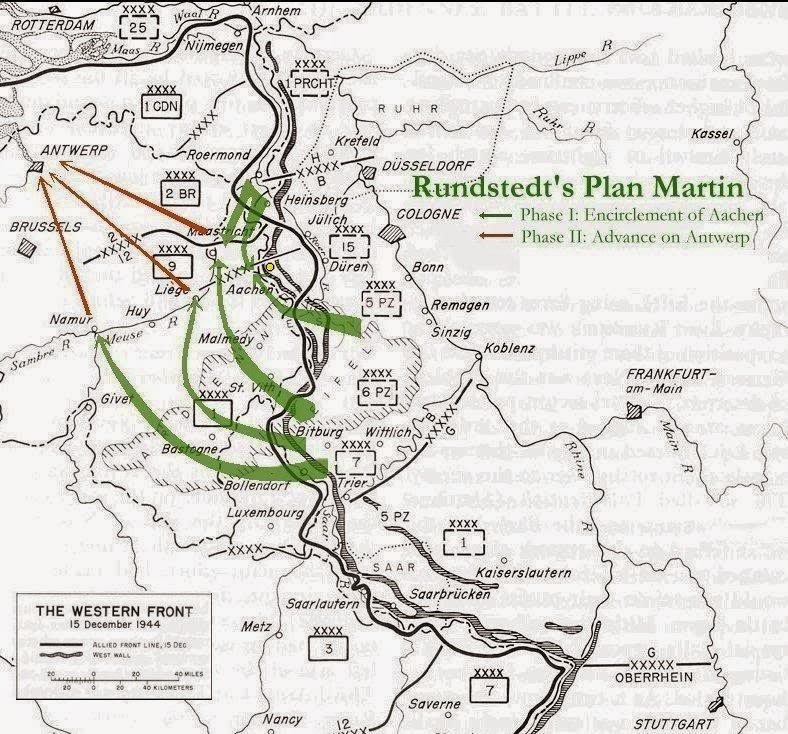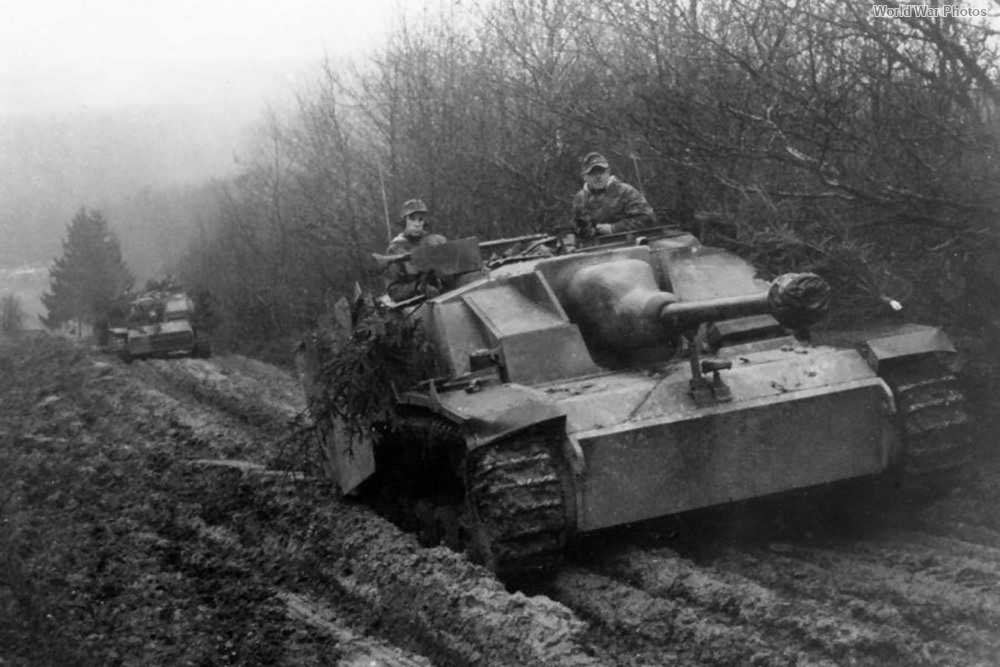Kingfish wrote: ↑12 Nov 2020, 12:24
The problem with this option is it directs the panzer spearheads towards what was arguably the most concentrated grouping of American forces at that time -and- the worst terrain. Recall that in the OTL the Germans made very little headway in this sector, whereas the 5th Pz army had better success further south against the overstretched US 28th infantry division.
Not exactly. The historical offensive around Monschau-Ketternich and Elsenborn turned out so badly because of it not being weighted in those directions and severe bungling by 6th Panzer Army's command structure. Turns out the SS were a bunch of incompetents and botched a ton of things all around. Of course loading up the Ardennes with the entire invasion force screwed up deployments too, as trying to cram all those divisions and their logistics in one region was a traffic jam waiting to happen.
5th Panzer army did much better due to better planning and conduct of operations. They actually had worse terrain and arguably a tougher enemy to face, but were able to overcome it through better planning despite having some pretty bad divisions in the initial assault (62nd VG made up of Polish and Czech conscripts many of whom deserted or surrendered at the first chance).
This alternate scenario is kind of tough to explain without getting into gruesome detail about the entire plan and comparing and contrasting it to what happened historically. Basically the short version is the US forces were actually extremely weak in a key sector at Monschau, with two reinforced battalions, one infantry from the 99th division and one a cavalry squadron, holding 8 miles by themselves. Historically they were supposed to have been attacked by a fresh, heavily reinforced (including by Jagdtigers) VG division, but due to a bunch of screw ups and bad luck the attacking division had none of it's non-artillery attachments and only 2.5 battalions, so was actually weaker than the defending forces; not only that, but they botched the timing, so that the attacks against each US battalion went off at different times, which allowed US artillery to concentrate against each staggered attack in turn with predictable results. Plus for some reason they attacks went in against the US strong points instead of against their relatively open flanks (holding 8 miles means there are going to be gaps that could have been exploited by infiltration at night much like around the Schnee Eifel), which is a characteristically stupid SS failing.
In this alternate scenario the 5th Panzer Army would conduct the offensive in this region instead and use their better planning and tactics (especially infiltration at night as they did at Schnee Eifel in the Ardennes historically instead of un-preregistered artillery bombardment without prior patrolling to figure out the US defensive layout as the SS did historically in this area) with a better VG division (I'm thinking the 26th VG division, the best in the Ardennes campaign) supported by a Panzer division for exploitation (I'm thinking 116th since Panzer Lehr had just been removed from the fighting in Lorraine) would be able to breakthrough with ease and exploit to Eupen by the late morning...which would net them V Corps HQ and cut the Main Supply Route to 2nd and 99th divisions at Elsenborn Ridge, which would mean they are knocked out of the fight extremely quickly as their artillery would run out of ammo on the 16th or 17th. Historically the 99th was short on artillery ammo on the 16th and it was resupply in subsequent days that saved them, as artillery was their best weapon against the attacks. The loss of V Corps HQ would also paralyze command of the entire corps at the critical moment. 1st division in R&R wouldn't likely be activated for a while and exploitation Panzer units then might even catch them unprepared in their rest area north of Eupen. Also since Eupen was the MSR into the Aachen area as it was the highway from the supply dumps around Vervier-Liege, it would also cut off the forces needed to counterattack from their supplies and command.
So the historical run of the Elsenborn ridge saga would be entirely changed from the very start of the offensive. Not only that, but so would everything else with US reinforcements to the region, as the attack out of the Roermond Triangle would mean 7th armored and 30th division aren't able to be sent into the Ardennes and Elsenborn areas, they'd be locked down defending against the attack on their flanks. Furthermore 9th armored's combat command that was sent to St. Vith was actually with 2nd infantry division around Elsenborn on the 16th, so would get sucked into the fighting around Monschau after that was already decided, so wouldn't be able to redeploy, nor able to retake Monschau given the forces that would be taking and holding it I mentioned above and would get pocketed along with 99th and 2nd infantry divisions. So the historical forces that saved St. Vith wouldn't be there in this scenario and even with the incompetent 6th Panzer army's SS leadership they should be able to break through the 106th division more quickly than historically as a result, which means full exploitation on the 17th by the SS panzer corps to the Meuse as there would be nothing standing in their way unlike historically.
To make matters even worse for the US forces the area around the Losheim gap would be run by professional army instead of the SS, which means if they did their historical tactics, night infiltration to clear out weakly held gaps before the main offensive at day break, the Lanzerath area would be cleaned out by morning on the 16th and rather than try to push into Losheimergraben the 5th Panzer army would send a panzer division through the Losheim Gap and Peiper's historical route a full day earlier. That would be 2nd Panzer division, arguably the best panzer division used in the Ardennes given the level of experience the troops in the division had since it had an unusual number of veterans left. If they get through on the morning of the 16th then the US forces are really screwed because then there is really nothing between them and Spa, which was 1st Army HQ. If they are able to take that through surprise on the 16th then US defenses are basically finished, as they'd have no coordinating HQ for days thereafter. Plus the vast supply dumps built up over months for the invasion of the Rhineland, the largest the US had in Europe per the US official history of the Ardennes offensive, would be captured intact. If they make it that far Liege falls late on the 16th or the morning of the 17th, which is fatal to the Allied armies in the region, as their supplies are gone (the rail line from Antwerp terminated at Liege) and reinforcements from the British are blocked.
So rather than being able to anchor US positions on the Northern Shoulder of the bulge offensive the Elsenborn ridge defense line effectively collapses on day 1 of the offensive when cut off from HQ and supply as well as all the historical reinforcements being sucked into battles in different areas or paralyzed due to their command being knocked out very early in the offensive. If that all happens on the 16th-18th, with the Roermond triangle forces (2 panzer divisions and 1 panzergrenadier division, the outer wing of the northern pincer) being able to take Maastricht on day 1 (it was only 30km from their jump off points and only the British 7th Armoured was partially on line to stop them with part of 52nd division in reserve) then they'd also knock out or disrupt the 9th army HQ plus cut off supplies and reinforcements to 9th army and the British divisions east of the Meuse in the southern Netherlands. That would effectively render the entire US 1st and 9th armies supply and command -less within the first day or two of the offensive staring along with several British divisions in the region too. If the attack against the 12th AG HQ (detailed below) also happens on the 18th and successfully disrupts them or even captures them, which also blocks 3rd Army reinforcements north using their historical route, then the US forces are in huge trouble. 3rd Army of course could route around Luxembourg, but that would be a pretty long, costly detour and I don't see Patton not attacking the Germans in Luxembourg if they're right there. If he lets his forces bog down in Luxembourg then they're not helping in the bulge, which is bad news for 1st army.
Kingfish wrote: ↑12 Nov 2020, 12:24
In addition, in the OTL the German 7th army barely made it to just south of Bastogne before enemy opposition forced a halt. Expecting it to cover the southern flank all the way to Namur is highly unrealistic to say the least.
In this alternate plan 7th army wouldn't even go for Bastogne, they'd be directed north of it to cover the flank that would turn further north than the historical offensive. As I said in the post with the map the map itself is inaccurate; 7th army in Rundstedt's proposal wouldn't even try to go that far west to Namur. Also in this alternate layout they'd likely be reinforced with 2nd SS Panzer division, perhaps 17th SS, both Fuehrer brigades, and maybe some more VG divisions. I've seen one proposal that they incorporate the Trier alternative as part of 7th Army's scheme of action too, so in this scenario 2nd SS and several other units like the Fuehrer brigades would attack a couple of days after the offensive started out of Trier against Luxembourg city to take out the radio transmitter there, the most powerful in Europe, and 12th AG HQ as well as block/disrupt the transfer of 3rd Army divisions north against the flank of 7th army.
Looking at the 12th AG situation maps from December 10th-31st if they attacked by the 18th (when the Fuehrer Brigades should be ready to go) they'd be facing quite weak opposition, as historically the Bulge had sucked in what divisions were detailed to defend Luxembourg and 3rd Army's was still organizing to send the bulk of its divisions northeast. Also Bradley wouldn't be at his command post, but meeting with Ike in Verdun, so 12th AG HQ would be without its commander.

